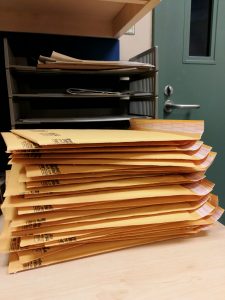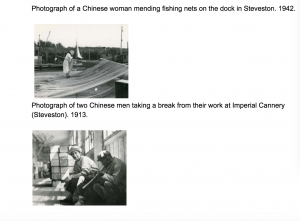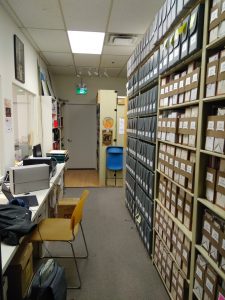Following Research
Recently, I continue working on the project-Making of an Archive, my curator Shaun assigned more important tasks to figure out. Few days ago, we ended the artist’s talk that gave a presentation related to her ideas of collecting and documenting photos of immigrants’ everyday life. At this moment, I went to the archive besides our gallery where some photo documentations have already been installed. Those photos represent the history of Canadian immigrants from last century to the contemporary context, in order to narrow down the topic of a research that Shaun assigns to me, I focused on several keywords and searched all through their database. There are eight words in total: celebration, parade, protest, wedding, religion, rally, temple and cannery. For each word typed on a website of the Richmond archive, there are some digital images relating to its content.



At the beginning, it is easier to find many photos attached to my keyword, and I have payed attention to similarities among those people’s life. For example, “cannery” included landscapes at the waterfront of Steveston, and interiors of canneries with their workers doing different jobs. Although they have gotten distinctive positions on the process of producing canned fish, it was hectic for workers to finish simple works as obvious appearances of exhausted, little bit annoying faces on them. The similarity we could find is their unwillingnesses devoting to the work whenever it is filled with troubles, such as strong smells that we could imagine in that scene. According to personal feeling, workers who were from overseas countries may be experiencing the inevitable bouts of homesickness due to the “cultural shock” or “cultural gap”in the multiple social context. It bring up a stubborn problem of social and cultural communication, even though more citizens joins into Canadian public communities andinstitutions, they could not real understand the conventional way in which native speakers are talking to each other. Some more professional translators have done countless works of diverse languages, yet they could not figure out this basic question: how do you translate words without interrupting the original meanings? As I do all the time, the transformation is taking place when you make use of your brain to decode distinctive passwords between two languages. 
Technically, grammars and spellings for each language are unique to be created and learned, but cultural meanings and symbols behind those are hardly accessible, metaphors of one single word or some slangs being a standard part of English have confused learners as well as their translators, the way to make balance between original contents and new one is literally ambiguous. The use of graceful sentences to make up untranslatable meanings of implications is usually to be expected.
In conclusion, those workers showed on photos of archives are culturally and socially different from the western areas, in specifically, the Canadian context. Especially for the language they speak is constructed distinctively in comparison with English. As a result, workers who were migrating to Canada from 19th century to early 20th century want to support their family by taking high incomes. However, they were shocked by the cultural differences originally produced by languages, communities and so on. I believed that making photo archives would be an imperative step to let people focus on the history as well as situations of foreign workers.
After checking and collecting photos documents in Richmond archives, we sent our requirements of possible resources of six photos: what are they from? which person donated photos and whether they are still alive or not? Importantly, we also want to clarify if there are additional sorties behind those photos. Unfortunately, archives are lacking more details on sources of photos and unable to review the date of submissions as time goes by quickly. But we have been informed to consult a biography of one artist called York Wong, who may created and owned more relevant information of immigrants. It could be regarded as a new stage for my research work, due to the limitation of time and space, I will continue my research with my partner Fiona on next Tuesday, at the same time, do some preparations of a night event.
For more information about the next week event, I will post on another blog.







